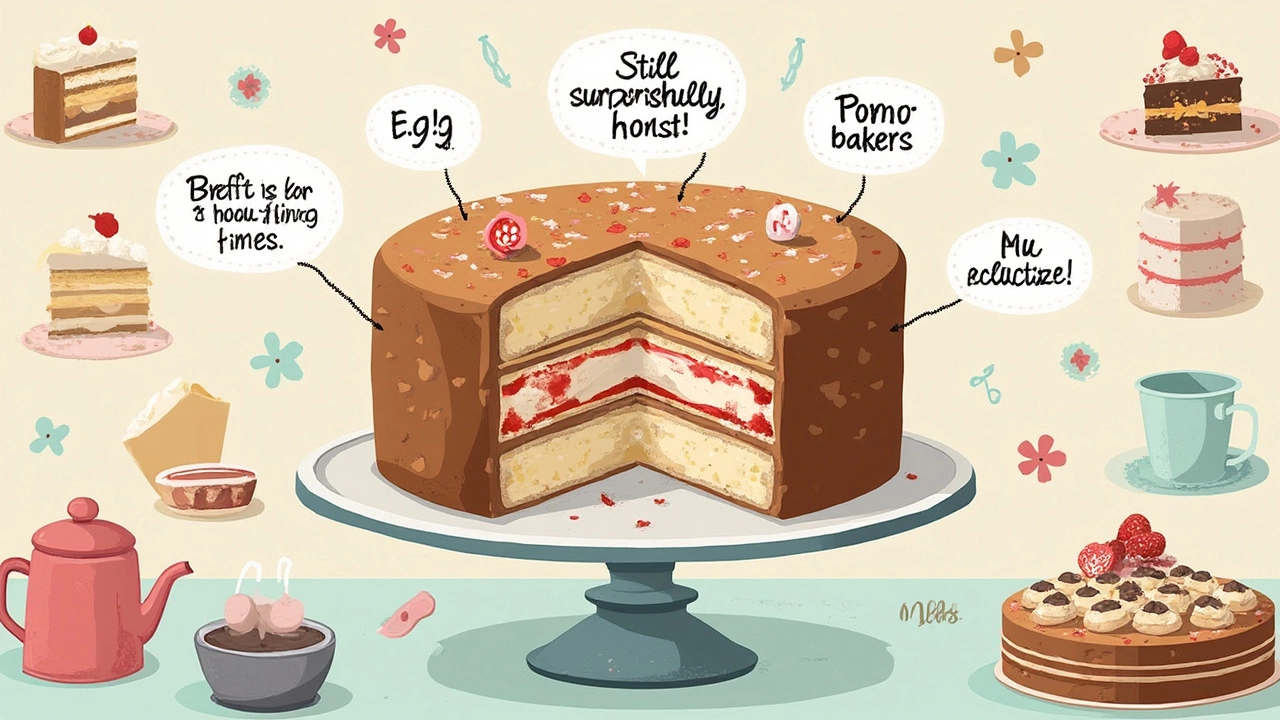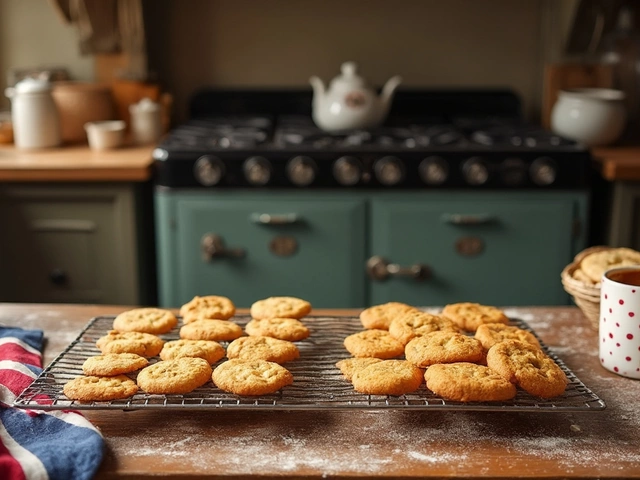Switching to gluten-free flour sounds simple, but baking a cake without gluten isn’t just a straight swap. Gluten gives cakes their light, fluffy texture. The second you take that out, things can get a bit weird—think dense, dry, or crumbly. So if you’re eyeing your favorite birthday cake recipe and wondering if you can just use a gluten-free blend, there’s a bit more to it.
You’ll notice right away that not all gluten-free flours are the same. Some are rice-based, some use almond or coconut, and a lot are mixed blends with weird names you’ve never heard of. Each one will affect your cake in a different way. The trick? Figuring out which blend is actually made for cakes, not just general baking.
One more thing people forget: gluten-free flour blends sometimes come with xanthan gum or guar gum already mixed in, which helps bind the cake and keep it tender. If your blend doesn’t have it, you’ll need to add a little bit, or else you’re baking a crumbly disaster. Check the label before you start dumping and mixing. These small steps make the difference between a cake you want to eat and one you feed to the birds.
- Why Gluten-Free Flour Changes Cake Baking
- Different Types of Gluten-Free Flours
- Common Pitfalls and Easy Fixes
- Tips for Best Moisture and Texture
- Choosing the Right Recipe for Success
Why Gluten-Free Flour Changes Cake Baking
Most people don’t realize how much regular flour does for cake. It’s not only there for structure—it’s got gluten, which is a protein that acts like sticky tape. When you beat the batter, gluten helps trap little air bubbles. This is what gives a cake that light, springy vibe when you bite into it.
Once you pull out gluten, you lose that built-in stretchy network. Suddenly, the cake batter has nothing to hold those air bubbles. This means cakes baked with gluten-free flour can turn out dense, crumbly, or even dry, unless you do some adjusting.
Here’s a side-by-side look at the difference gluten-free flour makes in cakes:
| Regular Flour Cake | Gluten-Free Flour Cake |
|---|---|
| Light, fluffy texture | Can be denser or crumbly |
| Rises evenly | Sometimes rises unevenly or sinks in the middle |
| Moist crumb structure | Prone to drying out fast |
| Neutral flavor | Blends can taste a bit grainy or strong |
But it’s not all bad news. Thanks to better flour blends and baking add-ins like xanthan gum or psyllium husk, you can mimic that sticky texture pretty well. Still, you might need to tweak your favorite recipe. A swap isn’t always one-to-one—and trust me, ignoring this fact often leads to lopsided cakes and some pretty disappointed taste testers.
If you want your gluten-free cake to turn out close to the real thing, remember this change is a big deal. Pick the right blend, double check for binders like xanthan gum, and don’t be afraid to experiment. The more familiar you get with how gluten-free flours act, the easier it is to get those fluffy results everyone loves.
Different Types of Gluten-Free Flours
Stepping into the world of gluten-free flours is like walking through a wild grocery store aisle—there are so many choices, and not all will make a great cake. So, how do you pick the right one? Let's break down the types that'll pop up on the shelf and what they actually do to your baking.
Gluten-free flour blends are usually designed to copy the role of regular wheat flour, but results can swing a lot based on what’s inside the bag. Most mainstream brands use a mix of rice flour, potato starch, and tapioca flour. That trio offers a pretty neutral flavor, close to what you’re used to, but might sometimes leave a gritty feel—especially with cheap rice flour.
Here’s a look at the most common gluten-free flour options and what they do:
- Rice Flour: Light and cheap, but high in starch so it soaks up moisture. Works better in blends than alone.
- Potato Starch: Adds softness and rise but can taste bland if overused.
- Tapioca Flour: Brings chewiness and helps with structure. Too much can make cakes gummy.
- Almond Flour: Gives a slightly sweet, nutty flavor, and keeps cakes moist. But it’s heavy—don’t use it alone unless you like dense treats.
- Coconut Flour: Very absorbent. You’ll need a lot more liquid (or eggs) if you use this one. Its flavor is strong, so be ready for a coconutty cake.
- Oat Flour: Soft and mild, it works great for muffin-like cakes, but make sure it’s labeled gluten-free (cross-contamination is a thing).
Some flours, like sorghum or buckwheat, also show up in blends. If you want a shortcut, buy an all-purpose gluten-free blend—King Arthur, Cup4Cup, and Bob’s Red Mill are the big players. Bob’s Red Mill even has a blend specifically for cakes and brownies.
“Not all gluten-free flours are created equal—some won’t bind or rise the way cake requires. That’s why most expert bakers use a blend, not just one flour.” — Celiac Disease Foundation
Check out this quick chart to compare popular gluten-free flour blends:
| Brand/Type | Main Ingredients | Best For | Notes |
|---|---|---|---|
| King Arthur Measure for Measure | Rice flour, whole grain brown rice, potato starch, tapioca | Cakes, muffins, cookies | Neutral taste, good texture |
| Cup4Cup Multipurpose | Rice flour, cornstarch, milk powder | Cakes, pastries | Works cup-for-cup in most cake recipes, very soft crumb |
| Bob's Red Mill 1-to-1 | Rice flour, potato starch, sorghum, tapioca, xanthan gum | Cakes, brownies | Very reliable, includes binder |
| Pamela’s All-Purpose | Brown rice, potato starch, tapioca, sorghum, arrowroot, guar gum | Cakes, quick breads | More wholesome flavor, moisture holds well |
When you want to bake a cake that’s not just dry or crumbly, grabbing a blend with a binder like xanthan gum (or adding some yourself) can save your bake. Try a small test batch before you make a birthday-sized cake for a crowd. Baking gluten-free is never boring, but with the right flour, it doesn’t have to be scary either!

Common Pitfalls and Easy Fixes
When you swap regular flour for gluten-free, trouble can start fast. The most common mess-ups are dry cakes, gummy middles, or cakes that fall apart when you try to slice them. These issues aren’t random—they’re caused by how gluten-free flour behaves in the mix.
Let’s break down the biggest issues along with the fixes that actually work:
- Gluten-free flour soaks up more liquid. If you stick to the original amount of milk, water, or eggs, your cake can turn out dry. Try adding 2 to 4 more tablespoons of liquid (like milk or even applesauce) per recipe. This extra moisture helps the cake come out soft and easy to cut.
- If your cake always sinks in the middle, the flour might be too heavy or not mixed well enough. Don’t be afraid to beat the batter a little longer than usual—this helps everything combine and gives better lift.
- Crumbly slices fall apart because gluten-free flour lacks the natural binder. That’s where xanthan gum or guar gum come in. If your blend doesn’t say it already includes one, add about 1/2 teaspoon per cup of flour. This small bit makes a huge difference in keeping cakes together.
- Weird flavors can pop up with bean-based or strong-tasting flours (like chickpea). If you notice a funny taste, stick to blends made for baking cakes—usually a mix of rice, potato, and tapioca flours. Subtle flavors won’t mess with your recipe.
- Browning can be different too. Gluten-free cakes sometimes stay pale. If you want a golden top, try brushing a bit of melted butter on before baking. It’s a trick that works in a pinch.
If you want a quick look at how gluten-free cakes compare to regular ones, check out this table with real baking results:
| Issue | All-Purpose Flour Cake | Gluten-Free Cake | Easy Fix |
|---|---|---|---|
| Texture | Soft, fluffy | Can be dry or dense | Add more liquid, don’t over-bake |
| Slicing | Holds together | Crumbly | Add xanthan/guar gum |
| Taste | Neutral | Sometimes off-flavors | Use mild, cake-specific blends |
| Appearance | Golden brown | Sometimes pale | Brush with butter before baking |
You don’t have to be a pro baker—just be ready for a bit of trial-and-error. Once you know these quirks, you can fix most problems without dumping out a whole cake.
Tips for Best Moisture and Texture
Nobody wants a dry, crumbly cake—especially not when you’ve spent extra cash on gluten-free flour. The key to a moist, soft crumb comes down to smart swaps and little adjustments from your usual baking game.
- Add More Moisture: Gluten-free flours soak up extra liquid. Toss in a couple tablespoons more milk, yogurt, or even applesauce than your regular recipe calls for. This helps the cake stay soft and yummy.
- Don’t Skip the Binder: A little xanthan gum or guar gum is your friend if you want a cake that holds together. Most blends need about 1/2 teaspoon per cup of flour (unless it’s already mixed in).
- Mix Don’t Overmix: With gluten-free cakes, you don’t get the stretchy, elastic gluten. So, overmixing can lead to dense, gummy cakes. Just mix until it’s combined, then stop.
- Go for Oil Instead of Butter: Cakes made with oil stay softer and fresher longer because oil coats the flour better and adds more moisture than butter.
- Blend Your Flours: If you’re feeling adventurous, combine different gluten-free flours (like rice and almond) for a better balance of structure and softness.
Want to see what works? Here’s a quick look at how a few liquid add-ins measure up by the numbers:
| Add-In | Standard Recipe (per cake) | Suggested Gluten-Free Swap |
|---|---|---|
| Milk | 1 cup | 1½ cups |
| Applesauce | 0 | 1/3 cup |
| Yogurt | 0 | 1/2 cup |
Finally, always check for doneness early—gluten-free cakes can brown fast but still be raw inside. A toothpick in the center should come out mostly clean. If you’re baking in layers, freeze your cakes for 30 minutes before frosting; it keeps the crumb tight and stops breakage. These small moves make a big difference when you want a gluten-free cake worth bragging about.

Choosing the Right Recipe for Success
Not every cake recipe is meant for gluten-free flour. Swapping regular for gluten-free flour in your old family cake recipe? You might end up with a weird texture or a flavor that's a little off. So, the safest move? Look for recipes that are written just for gluten-free flour.
Recipes designed for gluten-free flour usually include extra binding agents like xanthan gum or guar gum. These aren’t fancy add-ons—they seriously keep your cake together. If you skip them, your cake can turn out crumbly or fall apart when you cut a slice. A lot of good gluten-free cake recipes use more eggs or sometimes yogurt to lock in moisture, too.
Big baking sites and gluten-free bloggers (think America’s Test Kitchen, King Arthur Baking, or Minimalist Baker) test their recipes with specific gluten-free flour mixes. They’ll even tell you which blend works best, so you don’t have to guess. For example, King Arthur’s Gluten-Free Measure for Measure Flour is made specifically to bake like regular flour, especially in cakes. Don’t wing it with the tricky flour blends—start with recipes that use trustworthy products.
Here’s a quick checklist for picking a reliable gluten-free cake recipe:
- Check that the recipe was tested with gluten-free flour blends (look for brand names, not vague advice).
- Make sure it includes a binding agent (like xanthan or guar gum—unless the blend already has it).
- See if there are extra eggs, yogurt, or applesauce for moisture—they help a ton.
- Scan the reviews or comments. If other bakers had good luck, odds are you will, too.
If you’re curious about how much ingredients change between regular and gluten-free cake recipes, peek at this data pulled from trusted baking sources:
| Ingredient | Regular Cake Recipe | Gluten-Free Cake Recipe |
|---|---|---|
| Flour | All-purpose (100%) | Gluten-free blend (100%) |
| Eggs | 2 | 2-3 (often 1 extra for moisture/binding) |
| Binding Agent | None | Xanthan gum or guar gum (½-1 tsp) |
| Liquid (milk/water/yogurt) | 1 cup | 1-1.25 cups |
Don’t be afraid to test a few recipes. Take notes as you go—gluten-free baking is trial and error, but there’s no reason your next birthday cake can’t be melt-in-your-mouth good if you start with the right formula.





